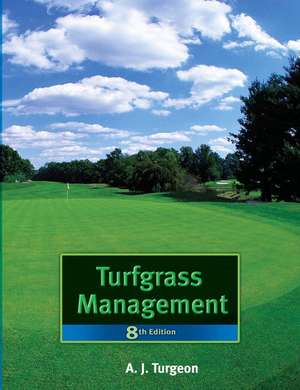Turfgrass Management: United States Edition
Autor A. J. Turgeonen Limba Engleză Hardback – 10 mai 2007
Rich with illustrations, Turfgrass Management, 8e is regarded for its thorough coverage of turfgrass science and technology. While covering the important features of turfgrass systems, interactions, and management, this book attempts to unlock some of the mysteries of turf and establish the role of cultural interventions in achieving specific objectives. Among its many updates, this edition features an expanded treatment of turfgrass physiology and biochemistry; more on improving environmental stress tolerance; new methods for alleviating soil compaction and improving drainage; and a section on spring transitions.
Preț: 536.29 lei
Preț vechi: 630.92 lei
-15% Nou
Puncte Express: 804
Preț estimativ în valută:
102.62€ • 107.43$ • 84.91£
102.62€ • 107.43$ • 84.91£
Carte indisponibilă temporar
Doresc să fiu notificat când acest titlu va fi disponibil:
Se trimite...
Preluare comenzi: 021 569.72.76
Specificații
ISBN-13: 9780132236164
ISBN-10: 0132236168
Pagini: 448
Dimensiuni: 178 x 235 mm
Greutate: 0.86 kg
Ediția:8Nouă
Editura: Pearson Education
Colecția Prentice Hall
Locul publicării:Upper Saddle River, United States
ISBN-10: 0132236168
Pagini: 448
Dimensiuni: 178 x 235 mm
Greutate: 0.86 kg
Ediția:8Nouă
Editura: Pearson Education
Colecția Prentice Hall
Locul publicării:Upper Saddle River, United States
Cuprins
1. Introduction
2. Growth and Development
3. Turfgrass Species
4. The Turfgrass Environment
5. Primary Cultural Practices
6. Supplementary Cultural Practices
7. Pest Management
8. Propagation
9. Cultural Systems
REFERENCES
GLOSSARY
APPENDIX 1: CONVERSION TABLES
APPENDIX 2: CALIBRATION
APPENDIX 3: COMMON AND CHEMICAL NAMES OF PESTICIDES USED IN TURF
2. Growth and Development
3. Turfgrass Species
4. The Turfgrass Environment
5. Primary Cultural Practices
6. Supplementary Cultural Practices
7. Pest Management
8. Propagation
9. Cultural Systems
REFERENCES
GLOSSARY
APPENDIX 1: CONVERSION TABLES
APPENDIX 2: CALIBRATION
APPENDIX 3: COMMON AND CHEMICAL NAMES OF PESTICIDES USED IN TURF
Caracteristici
For introductory courses in Turfgrass Management, Turfgrass Pest Management, and Turfgrass Cultural Systems.
Rich with illustrations, Turfgrass Management, 8e is regarded for its thorough coverage of turfgrass science and technology. While covering the important features of turfgrass systems, interactions, and management, this book attempts to unlock some of the mysteries of turf and establish the role of cultural interventions in achieving specific objectives. Among its many updates, this edition features an expanded treatment of turfgrass physiology and biochemistry; more on improving environmental stress tolerance; new methods for alleviating soil compaction and improving drainage; and a section on spring transitions.
Hallmark Features
Up-to-date, reference text–includes enough material to support introductory, secondary or intermediate-level courses.
Rich with illustrations, Turfgrass Management, 8e is regarded for its thorough coverage of turfgrass science and technology. While covering the important features of turfgrass systems, interactions, and management, this book attempts to unlock some of the mysteries of turf and establish the role of cultural interventions in achieving specific objectives. Among its many updates, this edition features an expanded treatment of turfgrass physiology and biochemistry; more on improving environmental stress tolerance; new methods for alleviating soil compaction and improving drainage; and a section on spring transitions.
Hallmark Features
Up-to-date, reference text–includes enough material to support introductory, secondary or intermediate-level courses.
- Covers all aspects of turfgrass science and technology.
- Offers flexibility because it can be used in numerous courses and as a reference text as well.
- Helps students grasp concepts, processes, and relationships of importance in turfgrass systems.
- Builds on feedback from pervious editions to include the most clear and meaningful illustrations.
- Facilitates understanding of how turfgrasses are adapted and cultural programs are developed at almost any location in the world.
- Includes new climatic maps that use computerized meteorological data acquired from multiple sites around the world.
- Examines primary cultural practices, supplementary cultural practices and pest management.
- Covers important aspects of turfgrass pest management, including those involved in the management of weeds, diseases, nematodes, insects, and large-animal pests.
- Shows students that pest problems can be reduced, or in some cases eliminated, by providing conditions that favor healthy turfgrass growth.
- Puts everything together into cultural systems employed for golf, sports, lawn, and utility turfs.
- Discusses the books concepts and how they related to specific types of turfs.
Caracteristici noi
New! Expanded treatment of hormones such as: brassinosteroids, jasmonic acid, and salicylic acid–see Chapter 2.
- Includes basic information on the role of these materials on turfgrass growth and development.
- References the most recent research regarding the effects of endogenous applications of these materials on turfgrass growth and stress tolerance.
- Shows how the innovative use of grow lights extends the photoperiod on summer-stressed turfs such as stadiums and golf courses.
- Explains how lamps that supplement natural sunlight can be used on shaded turfs to improve turfgrass growth and turf quality.
- Illustrates and explains the elements of a subsurface aeration system.
- Shows how to improve drainage by using a suction pump attached to drain pipes, and how to modify root zone temperature by pumping air through drain pipes.
- Moves this material earlier in the text to provide a clearer understanding of the topic.
- Reflects new methods for alleviating soil compaction and improving drainage.
- Includes new material on dealing with spring transition from over seeded cool-season grasses to the permanent warm-season turfgrass community.
